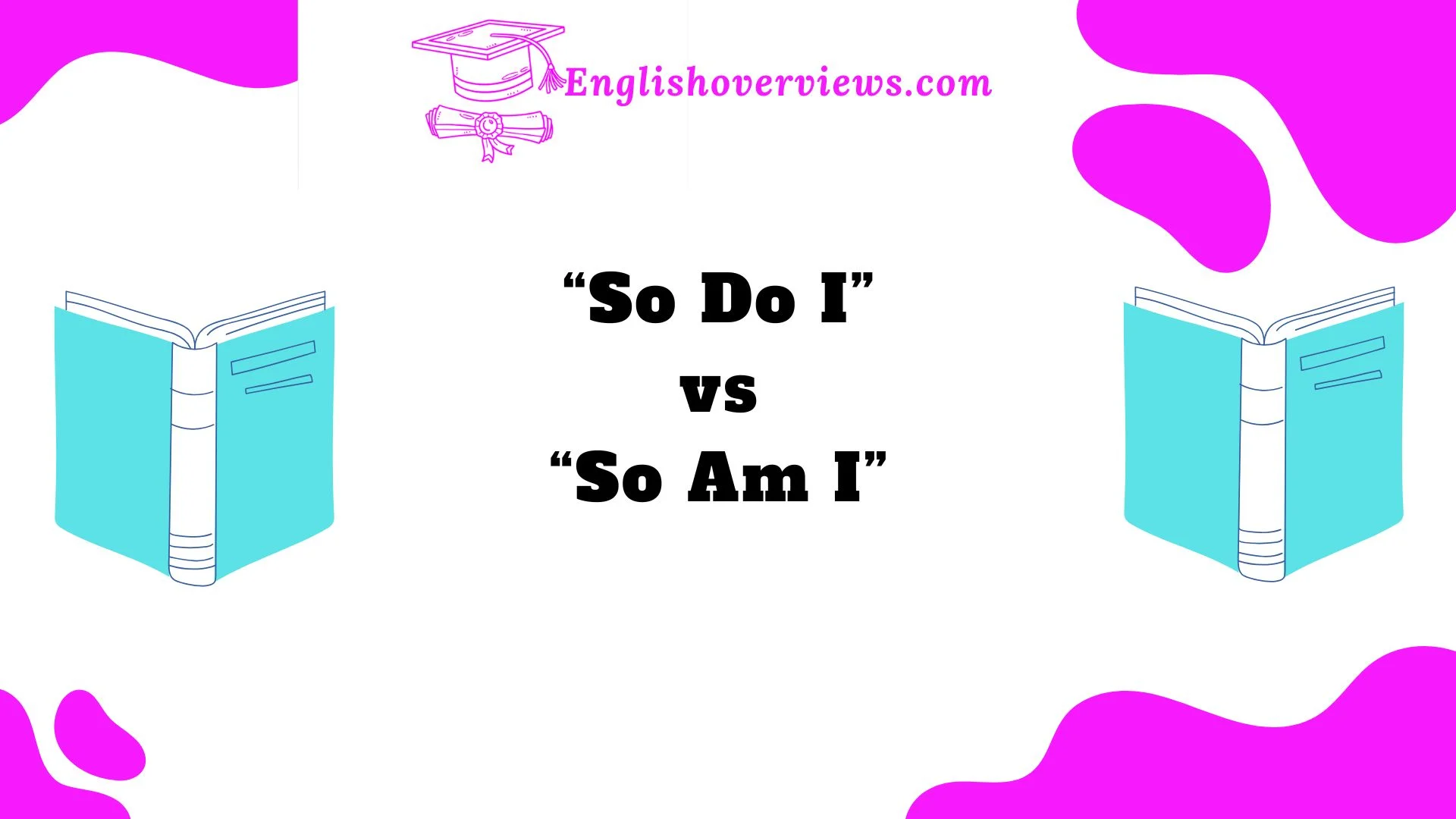Understanding the subtle differences between “So do I” and “So am I” can be a tricky challenge for English learners. These two expressions may seem similar, but they are used in different contexts.
If you’ve ever been confused about when to use “So do I” and when to use “So am I,” you’re not alone! This blog post will dive into these expressions, offering a detailed breakdown, real-life examples, and helpful tips so you can master them confidently.
By the end of this article, you’ll understand how and when to use each phrase in your everyday conversations. Let’s start by exploring the basics of how agreement works in English, and then we’ll break down “So do I” and “So am I” with clarity and examples.
Understanding Agreement in English: The Basics
Before we dive into the specifics of “So do I” and “So am I,” it’s important to understand the broader concept of agreement in English. In simple terms, agreement is when you respond to someone else’s statement by expressing a shared idea, action, or condition.
In English, you can agree with people using various structures. Two of the most common ways to express agreement are:
- Agreement with actions (verbs): These are responses that match what someone else is doing or has done.
- Agreement with states or conditions (adjectives and -ing verbs): These are responses that match someone else’s feelings, states, or conditions.
This is where “So do I” and “So am I” come into play. The key is knowing when to use each based on whether you’re agreeing with an action or a state. Let’s take a closer look.
“So Do I” – Aligning with Actions or Verbs
What is “So Do I”?
“So do I” is used to express agreement with someone’s action or verb in the present tense. When someone shares an action they’re currently doing or regularly do, you can use “So do I” to agree that you do the same thing.
When to Use “So Do I”
You use “So do I” when you’re agreeing with someone who’s talking about a verb in the present tense. For example:
- Person 1: “I like coffee.”
- Person 2: “So do I.”
Here, you’re agreeing with the action of liking coffee. - Person 1: “I run every morning.”
- Person 2: “So do I.”
This is an agreement with the action of running.
Real-Life Examples of “So Do I”
Example 1: Agreeing with Actions or Habits
- Person 1: “I wake up early every day.”
- Person 2: “So do I.”
Here, both people are agreeing that they share the same routine.
Example 2: Agreeing with Preferences
- Person 1: “I enjoy reading mystery novels.”
- Person 2: “So do I.”
The response shows agreement with the action of enjoying books.
“So Am I” – Sharing States or Traits
What is “So Am I”?
While “So do I” is used for agreeing with actions, “So am I” is used when you agree with someone’s state or trait. This typically refers to feelings, conditions, or states of being.
When to Use “So Am I”
You use “So am I” when agreeing with someone who is describing their state or condition. It works with adjectives or -ing verbs that describe how someone is feeling or what their current state is.
- Person 1: “I am tired.”
- Person 2: “So am I.”
Here, both people are agreeing with their current state of being tired. - Person 1: “I am excited about the trip.”
- Person 2: “So am I.”
This shows agreement with the state of being excited.
Real-Life Examples of “So Am I”
Example 1: Agreeing with States of Being
- Person 1: “I’m hungry.”
- Person 2: “So am I.”
Both are agreeing about their current state of hunger.
Example 2: Agreeing with Feelings or Emotions
- Person 1: “I am sad about the news.”
- Person 2: “So am I.”
This agreement shows that both people share the same emotional state.
Distinguishing “So Do I” from “So Am I” – Clarifying with Examples
Understanding the difference between “So do I” and “So am I” comes down to whether you’re agreeing with an action (verb) or a state (adjective).
Example 1 (Verb Agreement)
- Person 1: “I can swim.”
- Person 2: “So can I.”
This is an agreement with the verb “swim” and is in the present tense.
Example 2 (State Agreement)
- Person 1: “I am tired.”
- Person 2: “So am I.”
This is an agreement with the state of being tired, not an action.
Key Takeaway:
- Use “So do I” to agree with an action (verb).
- Use “So am I” to agree with a state (adjective).
Common Misconceptions About “So Do I” and “So Am I”
While “So do I” and “So am I” are fairly straightforward, there are some common misconceptions to clear up.
Myth 1: “So do I” can be used for both states and actions.
This is false. “So do I” is used only to agree with an action or verb. If someone talks about how they feel, you would use “So am I”, not “So do I”.
Myth 2: “So am I” works for actions or verbs.
Again, “So am I” is used specifically to agree with a state or trait. If you’re agreeing with an action, “So do I” is the correct phrase.
Analyzing Responses to Adjectives and -ing Verbs
Both “So do I” and “So am I” can be tricky when it comes to adjectives and -ing verbs (like feeling verbs). Here’s how to handle them:
Example 1: Adjectives
- Person 1: “I am happy today.”
- Person 2: “So am I.”
This shows agreement with the state of happiness.
Example 2: -ing Verbs
- Person 1: “I am enjoying this book.”
- Person 2: “So am I.”
This is agreement with the -ing verb describing the action of enjoying.
Analyzing Responses to Simple Verbs and Possessions
While “So do I” works with simple present tense verbs, it can also be used when agreeing about possessions.
Example 1: Simple Verbs
- Person 1: “I play the piano.”
- Person 2: “So do I.”
This agreement works because the sentence involves a present tense action (playing the piano).
Example 2: Possessions
- Person 1: “I have a dog.”
- Person 2: “So do I.”
Here, the phrase “So do I” is used to agree with possession.
Are “So Do I” and “So Am I” Ever Interchangeable?
In almost all cases, “So do I” and “So am I” are not interchangeable. The distinction between agreeing with an action versus agreeing with a state makes them function differently. However, in some rare cases, one may seem interchangeable depending on the context.
For example, if someone says, “I feel happy,” you can agree by saying, “So do I” (if talking about the verb feel) or “So am I” (if referring to the state of being happy). But, again, the context usually dictates which is more appropriate.
Extending the Concept: When to Use “So Did I”
Once you’ve mastered “So do I” and “So am I,” you can extend the concept to the past tense using “So did I.”
Example:
- Person 1: “I visited New York last year.”
- Person 2: “So did I.”
This shows agreement with an action that happened in the past.
Key Takeaway:
- Use “So did I” when agreeing with a past-tense action.
Conclusion
Now that you understand the difference between “So do I” and “So am I”, you can use these expressions confidently in conversations. Remember:
- “So do I” is for agreeing with actions or verbs.
- “So am I” is for agreeing with states or conditions. By keeping these distinctions clear, you’ll enhance your communication and avoid common pitfalls.
FAQs
1. Can “So do I” and “So am I” be used for questions?
No. These phrases are used for agreements with statements, not questions.
2. Can “So do I” be used in past tense conversations?
No. For past-tense agreements, you should use “So did I”.
3. Is it ever okay to mix “So do I” and “So am I”?
No. They are used in different contexts—one for actions and the other for states. Using them interchangeably would confuse your meaning.

English Overviews is a resourceful website dedicated to providing valuable content related to grammar and vocabulary. AD has made notable contributions, sharing insights on various subjects, including WordPress themes and plugins. The primary goal of the site is to help users improve their English language skills effectively.











